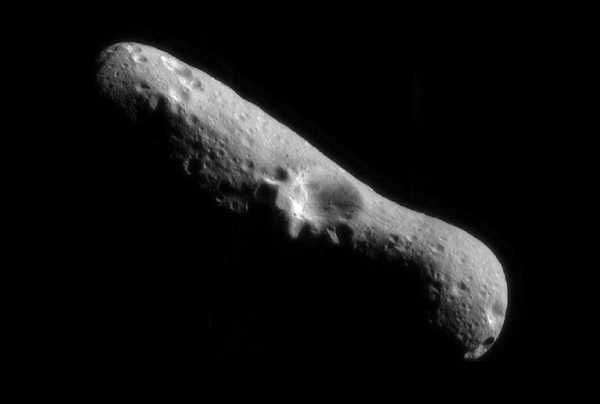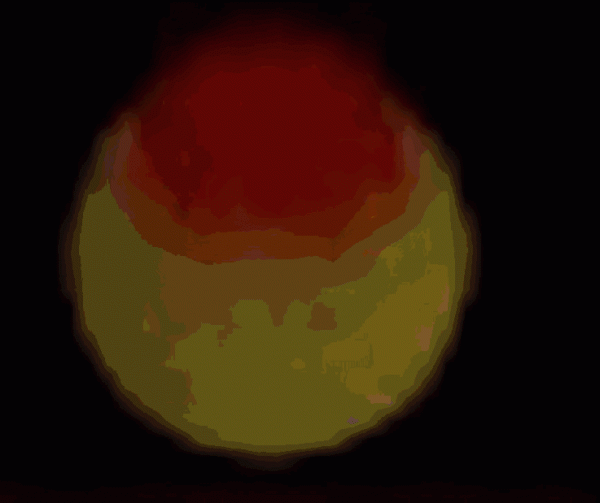
If you were a moviegoer in the late ’90s, I wouldn’t blame you for thinking the best way to deal with an apocalyptic-size asteroid hurtling toward Earth is to blow it to smithereens. After all, that’s how Bruce Willis saved the world in Armageddon. Saving the planet ought to be as easy as the press of a thermonuclear button, right?
Not so fast. For one, experts in planetary protection (a real thing) say it would be a lot simpler to just push a deadly incoming asteroid into a safer orbit. This is a real consideration because NASA is keeping its eye on about 2,000 ”potentially hazardous” objects that come within 4,647,790 miles of Earth and are large enough to cause damage.
But also there’s this: New research suggests it’s really, really difficult to pulverize an asteroid.
How hard can it be to destroy a 10-kilometer-wide asteroid?
Kaliat Ramesh is a professor of mechanical engineering and material science at Johns Hopkins University. And recently, he and colleagues published a paper in the planetary science journal Icarus that basically asked the question: What would it take to break up an asteroid? The answer to that question matters — but not so much for what it means for the future of life on Earth. Instead, it helps us better understand what asteroids look like, and how they evolve over time as asteroids collide with one another.
First off, there’s no way to do this sort of exercise without making some assumptions.
While we know that asteroids are mainly made up of iron and rock, we have limited data on their surface and interior composition. Any rock’s vulnerability to destruction is highly dependent on how many cracks, pores, and other such deformities exist on its surface. But Ramesh and his colleagues were able to take the results of experiments on Earth — experiments involving very high-speed cameras studying how rocks here on Earth fissure and crack when hit with a projectile — and extrapolate them up, accounting for the low-gravity environment of the space around an asteroid.
Related
If you die via asteroid, this is how it will happen
Smashed, fissuring rocks are a complicated thing to model in a computer. When cracks form on the surface, “you suddenly you get this collective behavior of cracks all trying to [move] really fast, all of them interacting with each other,” Ramesh says. How quickly those numerous cracks spread and form helps determine the resiliency of the rock. So it’s a massively complicated process to predict how a collision will change or deform a rock in space.
These limitations aside, Ramesh and his colleagues determined that, well, it’s going to be very hard to destroy an asteroid — near impossible. Even if there is an asteroid hurtling toward Earth, it wouldn’t make a lot of sense to launch the world’s entire nuclear arsenal at it in the hopes of blowing it up.
“We would estimate that it would take energy equivalent to about 200 gigatons of TNT to fully disrupt an asteroid with a 20-kilometer diameter,” Ramesh says. (This is roughly double the estimated size of the asteroid or comet that is believed to have killed the dinosaurs. But there is some evidence that Earth has been struck by a massive 20-kilometer asteroid in the past.)
200 gigatons of TNT (dynamite) contains roughly the energy equivalent of about 10 million Hiroshima-size bombs. It’s also about 10 times more energy than previous estimates of what it would take to destroy an asteroid of this size. (This new estimate takes into account the complex interactions between small cracks that form on the asteroid’s surface upon impact, which actually make for a more impact-resistant object.)
The most powerful bomb in human creation had an explosive yield of 50 megatons. You’d need the power of 4,000 of those to annihilate a 20-kilometer-wide asteroid. But even then, you couldn’t just launch 4,000 nuclear weapons to destroy the asteroid. That energy would need to be delivered with a particular momentum (that is, motion confined to a particular mass). Which is to say: you’d probably need to confine the force of 4,000 of the most powerful nuclear bombs into a projectile.
This research really isn’t about destroying asteroids. It’s about what to expect when we visit them.
The tremendous amount of energy needed is why we wouldn’t want to blow up an asteroid to save Earth.
But Ramesh stresses that his research isn’t exactly about finding out how to destroy an asteroid on a collision course with Earth. He’s well aware it would be a lot easier just to push an asteroid out of the way. (Which is something NASA has some preliminary plans for.)
In the paper, Ramesh and his colleagues weren’t modeling what a nuclear explosion would do to an asteroid. No, they were modeling something that happens naturally: What happens when one smaller asteroid slams into a larger one, as has happened continually over the life span of the solar system?
The answer to that question helps us understand what asteroids might look like if we were to explore more of them, and anticipate what might happen if we wanted to mine them (possibly with the use of explosives). Asteroids are rich sources of metals, minerals, and even water. They may one day provide the raw ingredients to refuel spaceships without the need to return to Earth.
Eventually, “humans and robots are going to go to an asteroid, and we want some sense of what we’re going to see when we get there,” Ramesh says.
Some robots already have. NASA’s OSIRIS-REx is currently orbiting the asteroid 101955 Bennu, with the eventual goal of collecting material from its surface and returning it to Earth in 2023 (a similar Japanese mission brought asteroid dust back to Earth in 2010). NASA’s Dawn spacecraft flew by the dwarf planets (which also can be thought of as very large asteroids) Ceres and Vesta in 2012 and 2015, respectively. NASA has laid the groundwork for an eventual “asteroid redirect” mission. The plan: A robot spacecraft will land on an asteroid, grab a boulder, and bring it into orbit around the moon.
Asteroids — like the ones humans might want to explore or mine one day for raw materials — have been subjected to such collisions over the life of the solar system. By imagining how asteroids collide and are destroyed (or not), we can better understand their composition and surface features, and how they evolve over time as more collisions take place. “We wanted to predict what we’d find on a surface of an asteroid if we’d go visit one,” Ramesh says.
When a large asteroid is pummeled by a smaller one, gravity keeps much of it together
One fascinating thing that happens when an asteroid is hit but is not destroyed is that much of the rubble that flies off after the collision is eventually pulled back toward the intact core of the asteroid via gravity. We could very well find asteroids that have this rubble loosely attached at the surface (and are therefore easy to mine). Here’s an animation of this recollection process generated by the researchers’ model.

These calculations also help us understand that if we were to destroy at least part of an asteroid, we could also be creating more hazardous objects.
The good news is that asteroids that pose an existential threat to life on Earth only strike once every 500,000 years or more. Even the 140-meter-wide asteroids that could destroy cities and regions hit once every 10,000 years. And the risk of even being injured from a 20-meter object — like the one that exploded over Chelyabinsk, Russia, in 2013 and hurt nearly 1,500 people — is tiny.
So instead of being worried about asteroids killing us, we should look at them in wonder. Asteroids are fascinating because they represent the leftover building blocks of the planets in our solar system. “You have all these [asteroid] bodies that have been around for a few billion years,” Ramesh says. “For us to understand the processes that drive these things over time, that is tied into the history of where we come from, and it’s also tied into our future, when we get out into the solar system and try to use them.”
Further reading: asteroids!
- How NASA hunts the asteroids that could smash into Earth
- If you die via asteroid, this is how it will happen
Sourse: vox.com






